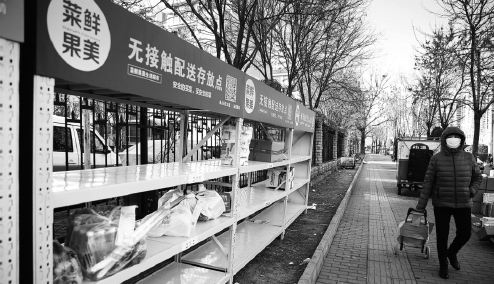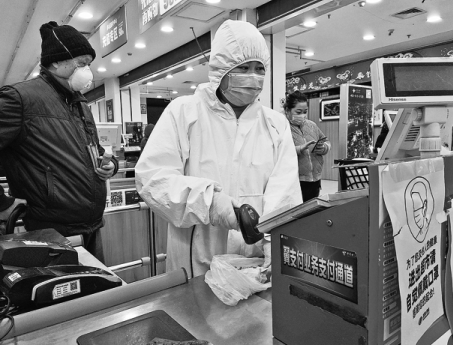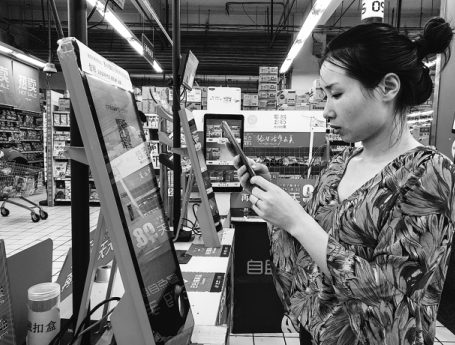Online platforms resurrect retail fortunes
Companies look to retain customers with speedy delivery solutions

Online platforms are fast becoming the go-to channel for multi-format retailers to expand and sustain their customer base, as the novel coronavirus outbreak has had a significant effect on traditional shopping patterns, experts said.
Between Jan 6 and April 15, fresh food sales on Walmart China's Daojia, its online mini program, and delivery platform JD Daojia rose nearly threefold, especially for items like pork, eggs, vegetables and fruit. The biggest demand was for domestically grown oranges, sales of which rose by 22 times on a yearly basis during the period. Not surprisingly, bulk of the transactions were undertaken via online platforms.
To meet the rapid demand for online shopping, retailers like Walmart have accelerated the development of prepackaged products and increased the ratio of such products to the merchandise available on their stores and online channels. By the middle of April, sales of onlineto-offline packaged pork at Walmart doubled on a yearly basis while vegetable sales rose by more than four times.
At the same time, the retailer is also offering more convenient catering choices for busy families amid work resumptions. Walmart has joined well-known restaurant brands including Xibei, Jindingxuan and Yunhaiyao in major cities to develop branded ready-to-eat dishes and have made them available through online platforms like Walmart Daojia and JD Daojia. Sales growth of such products rose by more than 60 percent during the April 13 to April 19 period, week-on-week.
More retailers are now utilizing delivery services to supply fresh food and groceries to customers, according to a report from Kantar Worldpanel, a market consultancy firm. Retailers who were able to withstand the novel coronavirus disruptions and grow their customer base were those who were able to offer fast and efficient delivery services, the report said.
Sales of "modern trade" channels, including hypermarkets, supermarkets and convenience stores, fell by 3.7 percept during the first quarter on a yearly basis, with supermarkets the least affected by the COVID-19 outbreak with a 0.5 percent fall. Small, mini super retail stores saw robust growth of 13.5 percent during the same period as they are closer in proximity to consumers needing top-up daily necessities, the report said.
Hypermarkets struggled during the first quarter, experiencing a 3.7 percentage point drop in penetration on a yearly basis, as cautious shoppers stayed away from shopping malls and crowds. Hypermarkets and supermarkets also shouldered the crucial tasks in securing the steady supplies of daily necessities during the epidemic, following the principles of "no price surge". Major hypermarket and supermarket operators quickly expanded their online presence, either via self-run applications, third-party mobile applications or mini programs on WeChat for deliveries. Smaller-sized retailers turned to online-to-offline platforms such as Ele.me and Meituan to increase their accessibility in cities, said Kantar.
E-commerce on the other hand witnessed a stellar performance with a growth rate of 22 percent, despite challenges in logistics as a result of road shutdowns and staff and supply shortages amid the outbreak.
According to the report, e-commerce now accounts for 19 percent of the total fast-moving consumer goods spend and is expected to continue to grow this year.
Among the top "modern trade" players, Sun Art Retail maintained a steady position thanks to its strong integration with the Taoxianda platform under Alibaba, said the report.
Last year, Sun Art Retail accelerated its transformation of the traditional hypermarket format to make the stores smaller and digitally strong to meet shopper needs. RT-mart also actively leveraged community group buy apps as well as its own delivery platform "Youxian" to maintain services during the first quarter, according to Kantar.
Supermarket chain Yonghui maintained a staggering growth of 9.8 percent in the first quarter, driven by its equity in fresh foods supplies and recent expansion to smaller "mini" formats to build advantage in proximity.
At the same time, local giants such as Wumart and Bubugao continued to grow faster than the market average, thanks to their well-managed supply capabilities and membership building as a result of regional focus.
Regional retailers are also rapidly adopting livestream-based platforms to attract shoppers while more consumers started turning to interactive shopping.
The Kantar report said that the total spend on fast-moving consumer goods recorded a drop of 6.7 percent in the latest quarter, compared with the same period in 2019.
According to the latest official data, retail sales of consumer goods declined by 19 percent on a yearly basis during the first quarter of this year. Sales in the food category declined by 7.7 percent year-on-year, with the confectionary and beverage sectors seeing substantial losses during the Lunar New Year and the subsequent lockdown period.
Against the backdrop of a declining FMCG market, the household products sector bucked the trend with a growth of 7.4 percent. The overall FMCG market started recovering since March 13 as new infections started subsiding.
The report found that younger consumers, who were leading the market growth in the past years, as well as consumers in the western region were more resilient during this period. Further recovery is anticipated, though the pattern of recovery will vary on a sectoral basis.
For the three-month period that ended on March 20, 62.6 percent of the urban households in China bought FMCG products online, up by 8.2 percentage points versus the same period last year. Consumption potential in lower tier cities drove the growth of e-commerce, which saw a 23.3 percent growth in value terms due to higher purchase frequency.
Meanwhile, as the demand for convenience and instant gratification surged, online-to-offline players including retailers' own delivery platforms like JD Daojia and Ele.me saw rapid growth in the first quarter.
Nearly 35 percent of urban families had made food purchases at least once via O2O platforms during the past three months. For example, at least 5,000 sets of ready-to-eat food products, jointly rolled out by Wumart and Dmall, were sold on the first day they went online.



Today's Top News
- Agreement boosts ocean governance
- Experts: Punishments law misinterpreted
- Project weaves global map of silk's grand history
- Cross-border research work bearing fruit
- Disrupting market under fabricated veneer of 'national security' hurts US' own interest: China Daily editorial
- Yasukuni visit would add insult to injury: China Daily editorial






























